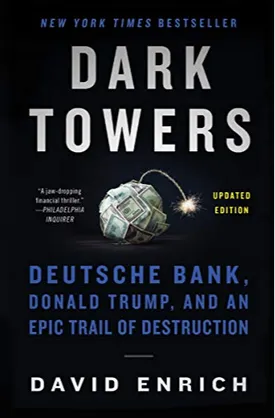Dark Towers: Deutsche Bank, Donald Trump, and an Epic Trail of Destruction by David Enrich
The Dark Towers: Deutsche Bank, Donald Trump, and an Epic Trail of Destruction, written by David Enrich, takes readers on a detailed journey of the intertwining paths of the international banking institution, Deutsche Bank, and the secretive businessman and now President, Donald Trump. Through Deutche Bank’s strategies of aggressively pursuing high-risk customers, looking the other way on certain accounting practices, and its relationship with Donald Trump, readers will gain insight into one of the most controversial banks in the world.
The first part of the book looks at the early inner workings of Deutsche Bank (DB). Throughout the 1980s and 90s the bank was run by a tight inner circle, ruthless and driven and prepared to do whatever it took to increase the bank’s market share. During this time, DB aggressively targeted high-risk customers, such as Russian oligarchs, corrupt dictators, and aspiring Third-World investors. They engaged in questionable accounting practices, such as recognizing income from long-term loans prior to the cash payments being received. This allowed the bank to spread its wings globally and become an international powerhouse.
The second part of the book delves into the close relationship between Deutsche Bank and Donald Trump. It highlights the unique access the bank had to Trump, long before he became President, due to the millions of dollars it loaned him over the years, even after his bankruptcy in the 90s. Enrich portrays the relationship between Trump and the bank as an “epic, mutually beneficial arrangement.” Trump was able to access Deutsche Bank’s deep pockets and voracious appetite for risk, while the bank could take advantage of the celebrity’s untapped potential. But the relationship was not without its drawbacks. Trump’s difficulty in paying back enormous loans and his propensity for filing lawsuits against DB caused much grief for the bank.
In the third part of the book, Enrich applies a forensic accounting lens to Deutsche Bank’s financial operations and uncovers a “thread of destruction,” or a period from 2007 to 2018 when the bank had significant problems. These issues included 1) vulnerability to market volatility, 2) questionable compliance practices, 3) a failure to cooperate with regulators, and 4) failure to recognize bad loans. Perhaps the greatest lesson to be found here is “the fragility of institutions that appear all-powerful.”
In the final section of the book, Enrich shifts his focus to Deutsche Bank’s current status. Despite numerous political and legislative attempts to interfere with its operations, the bank has managed to stay afloat by continuing its relationship with Donald Trump and by expanding its investment banking activities in Asia. In addition, the bank has implemented structural changes to its risk management and compliance operations, focusing on stricter oversight and better enforcing of risk management policies.
In conclusion, The Dark Towers: Deutsche Bank, Donald Trump, and an Epic Trail of Destruction by David Enrich provides an in-depth look into the relationship between DB and Donald Trump, as well as an exploration of the bank’s questionable accounting practices. Readers will gain insight into the business dealings of one of the world’s largest and most controversial financial institutions and the implications of its close ties to the 45th president of the United States.

